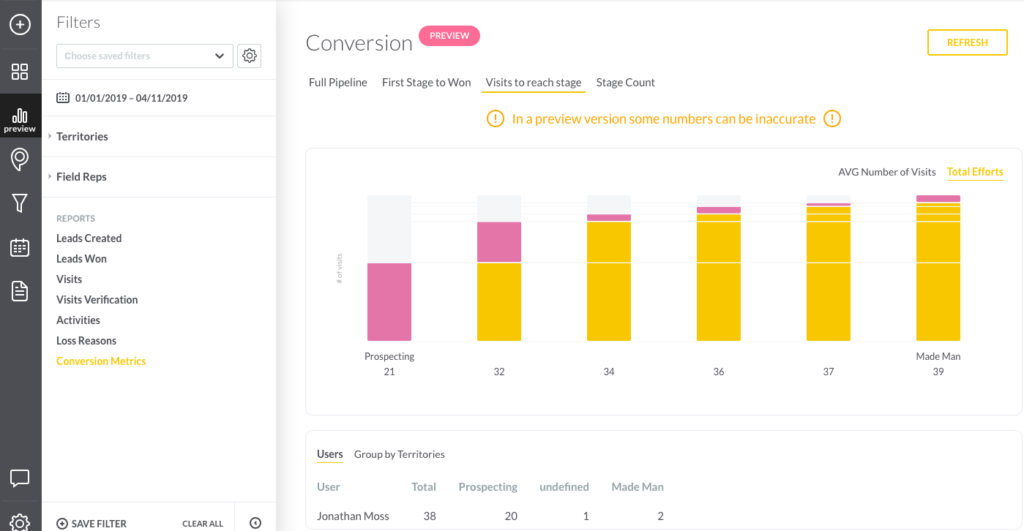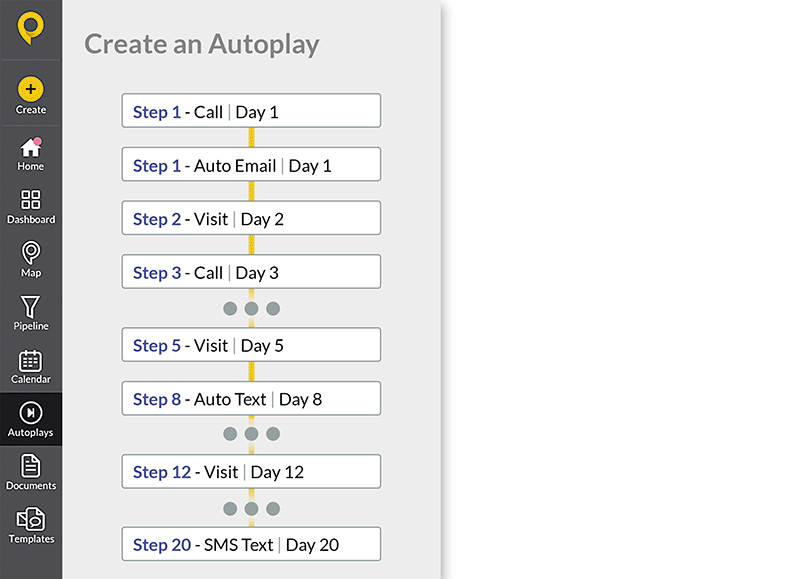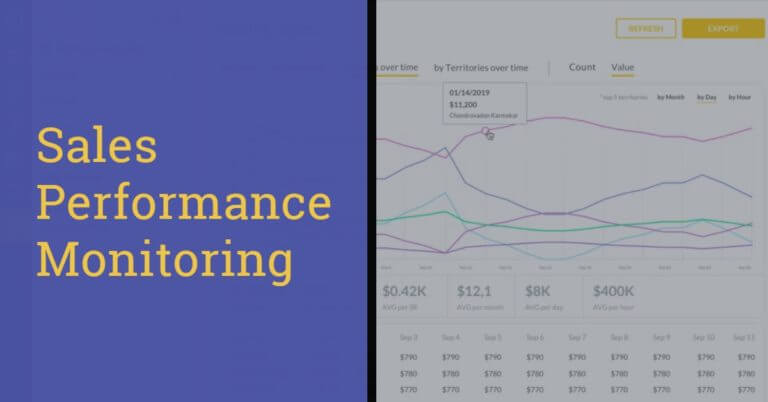Every sales manager has the same job: to improve performance for their sales department. They do this by analyzing data, then using said data to coach reps. That way they can achieve more individually, resulting in greater team success.
This is all well and good—as long as you have easy access to accurate data. Fortunately, a sales monitoring system will give you the information you need.
In this article, we’ll explain what a sales monitoring is, how this kind of tool will benefit your business, the four pillars of effective sales performance monitoring, how to build a sales monitoring system, and more.
What is a Sales Monitoring System?
Let’s start with a definition:
A sales monitoring system is designed to help sales managers monitor and facilitate their department’s sales processes and performance. As such, tools that fall into the “sales monitoring” category track rep activity and leads throughout the sales funnel, remind reps to follow up with prospects at opportune moments, capture engagement data, etc.
Once your department invests in a sales monitoring system, you’ll be able to increase rep productivity and accountability, forecast future sales with greater accuracy, and optimize your entire sales process.
Let’s talk more about these benefits…
How Do Businesses Benefit From a Sales Monitoring System?
There’s only one reason to invest in business software: because it will help you do and/or achieve something that you couldn’t before.
Here are five things a sales monitoring system will do for your sales department:
Greater sales forecast accuracy
Data is the lifeblood of your business—if it’s accurate and you know how to analyze it. Assuming you’ve locked down these two prerequisites, let’s talk forecasting.
Sales forecasts are crucial. Without them, you won’t be able to predict future results, which means you’ll have a hard time making proactive decisions to prevent issues from occurring.
For example, should you change sales strategies? Do you need to hire a new rep or two? Can management invest in product development? If you don’t have at least some idea of what you’ll make next month, these questions are difficult to answer.
Fortunately, sales performance tracking can help.
By monitoring your reps and the results they achieve, you’ll be able to more accurately predict future performance. Will it be perfect? No. Will it be helpful? Absolutely!
Increased rep accountability
Generally speaking, the best field sales reps put in the best effort. After all, you can’t close deals at a consistent clip if you don’t get out there and meet people.
A sales monitoring system will allow you to track sales rep activity metrics, such as where they’ve been while on the clock and the specific sales activities they’ve performed—making calls, sending emails, knocking on doors, etc.
However, for most companies activity reporting is still manual. As with any manual process, they can quickly become inaccurate as reps over-report results or procrastinate on entering data. Some sales monitoring systems help solve this by automating some of these manual tasks. By removing the human element from the process ensures your data remains accurate and relevant for your managers.
Knowing that you have access to this kind of information will help keep your reps accountable. They’ll be much less likely to “slack off” when they know you’ll ask them about it at your next on-on-one meeting. Nobody wants to have that talk!
Optimized sales processes
In many cases, the success of a sales team comes down to processes. Develop winning processes and you’ll close more deals. Fail to do so and you won’t.
A commitment to sales monitoring will give you the opportunity to evaluate your team’s sales processes on a regular basis. Are they working? Or do they leave something to be desired. If it’s the latter, you know you need to make adjustments.
When making adjustments, you’ll be able to A/B test different processes based on the information you’ve gleaned from your sales monitoring system. This will help you hit on more profitable strategies and boost conversion rates faster.
Increased rep productivity
An optimized sales process won’t just help you close more deals. It will help you close more deals in less time. This is because sales process optimization almost always leads to an increase in rep productivity.
Think about it: when your reps know exactly what to do in every sales situation they come across, they’ll be able to do it quicker.
But that’s not all. Due to technology, many aspects of your sales process can be automated, reducing the amount of work your reps have to do and freeing them up to spend more time selling. You know, what you actually hired them to do.
For example, tools like SPOTIO automatically log prospect interactions in real time, all but eliminating data entry tasks for sales reps and boosting their productivity levels by as much as 46%.

Image: SPOTIO automatically logs visits and cuts down on rep admin time.
Motivated reps and higher performance
As a sales manager, it’s your job to motivate your reps.
There are many different ways to do this. For example, you can use the data you glean from your sales monitoring system to coach your reps to greater success. The more success your reps have, the more motivated they’ll become.

You can also use SPOTIO’s Leaderboards feature, which will allow you to stir up a bit of friendly competition by displaying rep performance on a digital scoreboard of sorts. Rep motivation will increase when your team competes against each other.
What Are The Pillars of Sales Performance Monitoring?
Effective sales monitoring is built on four pillars: activity monitoring, lead monitoring, pipeline monitoring, and performance monitoring.
Let’s take a closer look at each one.
Activity monitoring
To close deals, your reps need to complete sales activities, such as calling and emailing leads, and meeting with prospects face-to-face.
Are they? If the answer is “no,” your department will have an extremely hard time generating pipeline, which is why your sales performance monitoring system should account for rep activity. Make sure your reps are putting in the work!
But not too much work…
The best sales monitoring systems automatically record rep activity so that they don’t have to worry about manual data entry. This leads to MUCH more accurate data because records are updated by software immediately, not by tired sales reps, who just spent a long day in the field and can’t remember every important detail.
Lead monitoring
Every company needs leads, which is why lead monitoring is essential. You can use your sales monitoring system to answer questions like:
- How many leads are your reps generating?
- What channels are these leads coming from?
- Are they qualified leads that fit your ideal customer profile?
- Which leads should your reps spend the most time on right now?
Answering these kinds of questions will help you evaluate your lead generation efforts and adjust them if necessary. It will also give you the chance to assign specific leads to specific reps, boosting your team’s close rate in the process.
Pipeline monitoring
Leads are great, but only if a portion of them become paying customers.
Pipeline monitoring will allow you to see the ways in which your leads move through your sales pipeline—or not. That way you can address bottlenecks and ensure more of your leads make it to the end of the buyer’s journey.

Image: Generate custom reports to monitor pipeline activity in SPOTIO.
Here are a few examples of the bottlenecks pipeline monitoring can uncover:
- Conversions: What’s stopping your best leads from becoming customers?
- Sales Cycles: Is the length of your sales cycle keeping leads from buying?
- Win Rate: Are your reps losing more deals than they win? Why is that?
Proper sales performance tracking will always include an element of pipeline monitoring so that sales teams can increase conversion metrics.
Performance monitoring
Finally, we have performance monitoring.
Are your reps meeting and/or exceeding expectations? What’s each rep’s lead to opportunity to closed sales conversion rate? How much revenue is each closed sale adding to your company’s top line? And who are your top performing sales reps?
Why are the important queries? Because answering them will give you direction.
For example, you may find that, after monitoring sales team performance, one of your reps generates a lot of leads, but has a poor close rate. You can investigate why this is and then help them adjust their approach to make more sales.
You might also find that one of your reps performs better than the others in almost every sales metric. So, when a must-win deal comes along, you can assign it to this top performer, giving your department the best chance to make the sale.
6 Steps in an Efficient Sales Monitoring Process
So how do you actually design a sales monitoring process for your company? It’s pretty simple: just follow these six steps and you’ll be good to go.
Set clear goals
What do you want your sales team to accomplish?
Give your reps clear goals that go beyond “making sales.” For example, you might want them to make X-number of sales calls per day. Or visit X-number of businesses on a weekly basis. Or maintain a 35% close rate.
Whatever your goals are, make sure your reps know about and understand them.
Automate sales processes
As mentioned earlier, automation will make your reps more productive. And more productive reps often outperform their less productive counterparts.
Take a look at your sales process and pinpoint elements that you can automate. Maybe you use a tool like SPOTIO to automatically capture prospect interactions. Or build an automated email sequence that generates sales on autopilot.

Image: SPOTIO Autoplays sequences field reps’ activities across each stage of the sales funnel.
Anytime you can use technology to make things easier for your reps, do it.
Track daily sales activities
Next, find a way to track daily sales activities for each of your reps.
Again, the easiest way to do this is with SPOTIO, which will tell you how your reps spend their on-the-clock hours and the results of their efforts. How many sales emails did Bob send last week? Did any of them generate a sale?

SPOTIO knows the answers to these questions. Even better, SPOTIO will send daily and/or weekly updates to your inbox so you never have to search for these details.
Monitor rep performance
If you’re tracking daily sales activities, you might as well track the results of them, too. In other words, you should be monitoring sales rep performance.
Amy might make a lot of calls and send a lot of emails—she’s a hard worker. But if her efforts don’t produce sales, does it matter? Not really. You need to know what your reps do on a daily basis (activity tracking) and the results of these activities (performance tracking) so that you can properly lead your team to success.
It’s not as hard as it sounds. SPOTIO is equipped to handle all of your performance monitoring needs so that you always know where your reps stand.
Coach your reps
Successful sales reps are often the byproduct of great coaching.
Now, it’s important to realize that coaching and micromanaging are NOT the same thing. Do your best to motivate, listen to, and guide your reps. Refrain from analyzing every small decision they make. This is a recipe for disaster.
Here’s an example: You notice that Jim’s sales numbers are the lowest in your department. After analyzing activity metrics in SPOTIO, you realize that Jim only sends 20 emails a day. Everyone else on your team sends at least twice that many.
You can handle this in one of two ways:
- Coaching: You can talk with Jim and ask him why he doesn’t send more emails. Jim will tell you it’s because he wants to make sure that each message is perfect, so he re-reads every email a dozen times before sending. You then suggest to Jim that he use the email templates that other sellers on your team use so that he can send high-quality emails in less time.
- Micromanaging: You call Jim in for a one-on-one meeting and tell him that his sales numbers are too low. Because of this, you’re stepping in to help—Jim’s going to be your “special project.” So, you give Jim a few email templates to use. Then you send Jim Slack messages every couple of hours to “check in” and see how he’s doing.
Be a coach, not a micromanager.
Invest in a sales monitoring system
Finally, we suggest investing in a sales monitoring system, which will make the entire sales monitoring process much easier. The question is, which sales monitoring tool should you build your system around.
Top Sales Monitoring Systems
Both inside and outside sales teams can benefit from a proper sales monitoring system. Let’s take a look at a few of the best options in this software category:
SPOTIO

SPOTIO is the ultimate tool for field sales teams, enabling them to grow revenue by 23% via intuitive lead generation, task automation, and sales tracking features.
Key sales monitoring features:
- View Rep Activities: Are your reps using the right channels? Are they putting in enough effort? Easily track calls, emails, texts, and visits.
- Analyze Rep Performance: Are the calls and visits your reps make effective? How about the emails and texts they send? SPOTIO will give you in-depth information regarding the results of your reps’ efforts in the field.
- Track Your Pipeline: Are there bottlenecks in your pipeline? SPOTIO will help you identify them. For example, you may find, after using SPOTIO, that your reps make a lot of introductions, but not many sales. You can then investigate the cause of this bottleneck and remove it.
- Create Custom Reports: Are you tired of complicated sales reports? SPOTIO’s “My Reports” feature will let you create custom reports based on the data that matters to you. Easily choose the date ranges, employee types, sales activities, pipeline stages, etc. you want information on.
- Forecast Future Results: How does next month look for your sales team? How about the month after that? The data inside SPOTIO will tell you how you’re doing now, as well as how you’re likely to perform in the future. You can then approach your executive team with more accurate forecasts.
Salesforce

Salesforce is one of the most popular CRM solutions in the world. With it, sales, marketing, service, and IT teams get the data they need to work more efficiently.
Key sales monitoring features:
- See Rep Activities: Salesforce will log the calls, emails, texts, and visits your reps make and/or send, reducing data entry tasks for your department and giving you the activity data you need for each member of your team.
- View Detailed Analytics: How many of the calls, emails, texts, and visits your reps make and/or send result in sales? Salesforce will help you find the answer, which you can use to adjust your sales strategy when appropriate.
- Predict the Future: Thanks to the rep activity tracking feature and the detailed analytics dashboard, Salesforce helps sales managers predict future results with more accuracy, which your executive team will appreciate.
Want to use Salesforce and SPOTIO? You’re in luck!
By integrating the two tools, you’ll be able to automatically update your Salesforce database with the information you collect in SPOTIO.
Pipedrive

Pipedrive is a popular “all-in-one sales platform” for inside sales teams. Thousands of customers use it to connect with qualified leads and grow revenue.
Key sales monitoring features:
- Track (Some) Rep Activities: With Pipedrive, you can automatically track the calls and emails your sales reps make, then easily access the information.
- Manage Your Pipeline: Pipedrive makes it simple to analyze your pipeline thanks to the highly visual nature of the tool. Pipedrive also includes a “deal rotting” feature, which notifies reps when deals stay idle for too long.
- View Essential Data Points: Lastly, Pipedrive gives users access to all key sales data, including the number of deals won and lost, why certain deals fell through, which activities produce the best conversion rates, and more.
Similar to Salesforce, Pipedrive integrates with SPOTIO, which means SPOTIO users can access their Pipedrive data from the SPOTIO mobile app.
Final Thoughts
Sales monitoring is an essential component of modern sales teams. Once you put a sales monitoring system in place, you’ll be able to keep your reps accountable, optimize your sales processes, and boost rep productivity and motivation levels.
Fortunately, modern software makes sales performance tracking a piece of cake!
If you manage a field sales team, consider investing in SPOTIO. Our platform was specifically designed to assist field sellers and the folks who manage them. As such, it’s equipped with all of the features you need to track individual field rep activities and performance, as well as manage your entire pipeline.
Contact one of our product experts today for a free demo of SPOTIO.



